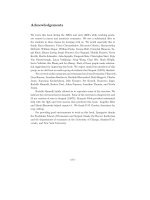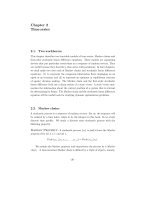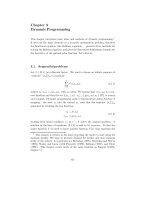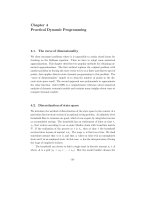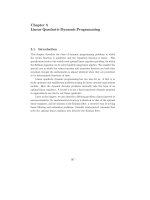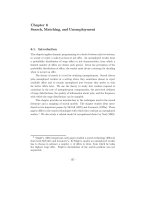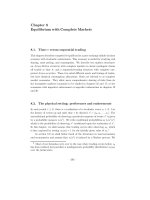Recursive macroeconomic theory, Thomas Sargent 2nd Ed - Chapter 23 pdf
Bạn đang xem bản rút gọn của tài liệu. Xem và tải ngay bản đầy đủ của tài liệu tại đây (306.36 KB, 34 trang )
Chapter 23
Two topics in international trade
23.1. Two dynamic contracting problems
This chapter studies two models in which recursive contracts are used to over-
come incentive problems commonly thought to occur in international trade. The
first is Andrew Atkeson’s model of lending in the context of a dynamic setting
that contains both a moral hazard problem due to asymmetric information and
an enforcement problem due to borrowers’ option to disregard the contract. It
is a considerable technical achievement that Atkeson managed to include both
of these elements in his contract design problem. But this substantial technical
accomplishment is not just showing off. As we shall see, both the moral hazard
and the self-enforcement requirement for the contract are required in order to
explain the feature of observed repayments that Atkeson was after: that the
occurrence of especially low output realizations prompt the contract to call for
net repayments from the borrower to the lender, exactly the occasions when an
unhampered insurance scheme would have lenders extend credit to borrowers.
The second model is Bond and Park’s recursive contract that induces moves
to free trade starting from a Pareto non-comparable initial condition. The new
policy is accomplished by a gradual relaxation of tariffs accompanied by trade
concessions. Bond and Park’s model of gradualism is all about the dynamics of
promised values that are used optimally to manage participation constraints.
– 817 –
818 Two topics in international trade
23.2. Lending with moral hazard and difficult enforce-
ment
Andrew Atkeson (1991) designed a model to explain how, in defiance of
the pattern predicted by complete markets models, low output realizations in
various countries in the mid-1980s prompted international lenders to ask those
countries for net repayments. A complete markets model would have net flows
to a borrower during periods of bad endowment shocks. Atkeson’s idea was
that information and enforcement problems could produce the observed out-
come. Thus, Atkeson’s model combines two features of the models we have seen
in chapter 19: incentive problems from private information and participation
constraints coming from enforcement problems.
Atkeson showed that the optimal contract the remarkable feature that the
job of handling enforcement and information problems is done completely by
a repayment schedule without any direct manipulation of continuation values.
Continuation values respond only by updating a single state variable – a mea-
sure of resources available to the borrower – that appears in the optimum value
function, which in turn is affected only through the repayment schedule. Once
this state variable is taken into account, promised values do not appear as in-
dependently manipulated state variables.
1
Atkeson’s model brings together several features. He studies a “borrower”
who by himself is situated like a planner in a stochastic growth model, with the
only vehicle for saving being a stochastic investment technology. Atkeson adds
the possibility that the planner can also borrow subject to both participation
and information constraints.
A borrower lives for t =0, 1, 2, He begins life with Q
0
units of a single
good. At each date t ≥ 0, the borrower has access to an investment technology.
If I
t
≥ 0 units of the good are invested at t, Y
t+1
= f (I
t
,ε
t+1
) units of time t+1
goods are available, where ε
t+1
is an i.i.d. random variable. Let g(Y
t+1
,I
t
)be
the probability density of Y
t+1
conditioned on I
t
.Itisassumedthatincreased
investment shifts the distribution of returns toward higher returns.
The borrower has preferences over consumption streams ordered by
U =(1−δ)E
0
∞
t=0
δ
t
u(c
t
)(23.2.1)
1
To understand how Atkeson achieves this outcome, the reader should also
digest the approach described in the following chapter.
Lending with moral hazard and difficult enforcement 819
where δ ∈ (0, 1) and u(·) is increasing, strictly concave, and twice continuously
differentiable.
Atkeson used various technical conditions to render his model tractable. He
assumed that for each investment I , g(Y, I) has finite support (Y
1
, ,Y
n
)with
Y
n
>Y
n−1
> > Y
1
. He assumed that g(Y
i
,I) > 0 for all values of I and
all states Y
i
, making it impossible precisely to infer I from Y .Hefurther
assumed that the distribution g (Y,I) is given by the convex combination of
two underlying distributions g
0
(Y )andg
1
(Y ) as follows:
g(Y,I)=λ(I)g
0
(Y )+[1− λ(I)]g
1
(Y ), (23.2.2)
where g
0
(Y
i
)/g
1
(Y
i
) is monotone and increasing in i,0≤ λ(I) ≤ 1, λ
(I) > 0,
and λ
(I) ≤ 0 for all I .Notethat
g
I
(Y,I)=λ
(I)[g
0
(Y ) − g
1
(Y )],
where g
I
denotes the derivative with respect to I . Moreover, the assumption
that increased investment shifts the distribution of returns toward higher returns
implies
i
Y
i
[g
0
(Y
i
) −g
1
(Y
i
)] > 0. (23.2.3)
We shall consider the borrower’s choices in three environments: (1) autarky,
(2) lending from risk-neutral lenders under complete observability of the bor-
rower’s choices and complete enforcement, and (3) lending under incomplete
observability and limited enforcement. Environment 3 is Atkeson’s. We can use
environments 1 and 2 to construct bounds on the value function for performing
computations described in an appendix.
820 Two topics in international trade
23.2.1. Autarky
Suppose that there are no lenders. Thus the “borrower” is just an isolated house-
hold endowed with the technology. The household chooses (c
t
,I
t
) to maximize
expression (23.2.1) subject to
c
t
+ I
t
≤ Q
t
Q
t+1
= Y
t+1
.
The optimal value function U(Q) for this problem satisfies the Bellman equation
U(Q)= max
Q≥I≥0
(1 −δ) u(Q −I)+δ
Q
U
Q
g(Q
,I)
. (23.2.4)
The first-order condition for I is
−(1 −δ)u
(c)+δ
Q
U(Q
)g
I
(Q
,I)=0 (23.2.5)
for 0 <I<Q. This first-order condition implicitly defines a rule for accumu-
lating capital under autarky.
23.3. Investment with full insurance
We now consider an environment in which in addition to investing I in
the technology, the borrower can issue Arrow securities at a vector of prices
q(Y
,I),wherewelet
denote next period’s values, and d(Y
)thequantity
of one-period Arrow securities issued by the borrower; d(Y
)isthenumberof
units of next period’s consumption good that the borrower promises to deliver.
Lender observe the level of investment I and so the pricing kernel q(Y
,I)
depends explicitly on I . Thus, for a promise to pay one unit of output next
period contingent on next-period output realization Y
,foreachlevelofI ,the
borrower faces a different price. (As we shall soon see, in Atkeson’s model, the
lender cannot observe I , making it impossible to condition the price on I .)
We shall assume that the Arrow securities are priced by risk-neutral investors
who also have one-period discount factor δ. As in chapter 8, we formulate the
borrower’s budget constraints recursively as
c −
Y
q(Y
,I)d(Y
)+I ≤ Q (23.3.1a)
Q
= Y
− d(Y
). (23.3.1b)
Investment with full insurance 821
Let W(Q) be the optimal value for a borrower with goods Q. The borrower’s
Bellman equation is
W (Q)= max
c,I,d(Y
)
(1 −δ)u(c)+δ
Y
W [Y
− d(Y
)]g(Y
,I)
+ λ[Q −c +
Y
q(Y
,I)d(Y
) −I]
,
(23.3.2)
where λ is a Lagrange multiplier on expression (23.3.1a). First-order conditions
with respect to c, I, d(Y
), respectively, are
c:(1− δ)u
(c) −λ =0, (23.3.3a)
I: δ
Y
W [Y
− d(Y
)]g
I
(Y
,I)+
λq
I
(Y
,I)d(Y
) −λ =0, (23.3.3b)
d(Y
): − δW
[Y
− d(Y
)]g(Y
,I)+λq(Y
,I)=0. (23.3.3c)
Letting risk-neutral lenders determine the price of Arrow securities implies that
q(Y
,I)=δg(Y
,I), (23.3.4)
which in turn implies that the gross one-period risk-free interest rate is δ
−1
.
At these prices for Arrow securities, it is profitable to invest in the stochastic
technology until the expected rate of return on the marginal unit of investment
is driven down to δ
−1
:
Y
[Y
− d(Y
)]g
I
(Y
,I)=δ
−1
, (23.3.5)
and after invoking equation (23.2.2)
λ
(I)
Y
[Y
− d(Y
)] (g
0
(Y
) − g
1
(Y
)) = δ
−1
.
This condition uniquely determines the investment level I , since the left side is
decreasing in I and must eventually approach zero because of the upper bound
on λ(I). (The investment level is strictly positive as long as the left-hand side
exceeds δ
−1
when I =0.)
The first-order condition (23.3.3c) and the Benveniste-Scheinkman condi-
tion, W
(Q
)=(1− δ)u
(c
), imply the consumption-smoothing result c
= c.
822 Two topics in international trade
This in turn implies, via the status of Q as the state variable in the Bellman
equation, that Q
= Q. Thus, the solution has I constant over time at a level
determined by equation (23.3.5), and c and the functions d(Y
) satisfying
c + I = Q +
Y
q(Y
,I)d(Y
)(23.3.6a)
d(Y
)=Y
− Q (23.3.6b)
The borrower borrows a constant
Y
q(Y
,I)d(Y
) each period, invests the
same I each period, and makes high repayments when Y
is high and low
repayments when Y
is low. This is the standard full-insurance solution.
We now turn to Atkeson’s setting where the borrower does better than under
autarky but worse than with the loan contract under perfect enforcement and
observable investment. Atkeson found a contract with value V (Q)forwhich
U(Q) ≤ V (Q) ≤ W (Q). We shall want to compute W(Q)andU(Q)inorder
to compute the value of the borrower under the more restricted contract.
23.4. Limited commitment and unobserved investment
Atkeson designed an optimal recursive contract that copes with two impedi-
ments to risk sharing: (1) moral hazard, that is, hidden action: the lender
cannot observe the borrower’s action I
t
that affects the probability distribution
of returns Y
t+1
; and (2) one-sided limited commitment: the borrower is free to
default on the contract and can choose to revert to autarky at any state.
Each period, the borrower confronts a two-period-lived, risk-neutral lender
who is endowed with M>0 in each period of his life. Each lender can lend or
borrow at a risk-free gross interest rate of δ
−1
andmustearnanexpectedreturn
of at least δ
−1
if he is to lend to the borrower. The lender is also willing to
borrow at this same expected rate of return. The lender can lend up to M units
of consumption to the borrower in the first period of his life, and could repay (if
the borrower lends) up to M units of consumption in the second period of his
life. The lender lends b
t
≤ M units to the borrower and gets a state-contingent
repayment d(Y
t+1
), where −M ≤ d(Y
t+1
), in the second period of his life. That
the repayment is state-contingent lets the lender insure the borrower.
A lender is willing to make a one-period loan to the borrower, but only if the
loan contract assures repayment. The borrower will fulfill the contract only if
Limited commitment and unobserved investment 823
he wants. The lender observes Q, but observes neither C nor I . Next period,
the lender can observe Y
t+1
. He bases the repayment on that observation.
Where c
t
+ I
t
−b
t
= Q
t
, Atkeson’s optimal recursive contract takes the form
d
t+1
= d (Y
t+1
,Q
t
)(23.4.1a)
Q
t+1
= Y
t+1
− d
t+1
(23.4.1b)
b
t
= b(Q
t
). (23.4.1c)
The repayment schedule d(Y
t+1
,Q
t
) depends only on observables and is de-
signed to recognize the limited-commitment and moral-hazard problems.
Notice how Q
t
is the only state variable in the contract. Atkeson uses the
apparatus of Abreu, Pearce, and Stacchetti (1990), to be discussed in chapter
22, to show that the state can be taken to be Q
t
, and that it is not necessary
to keep track of the history of past Q’s. Atkeson obtains the following Bellman
equation. Let V (Q) be the optimum value of a borrower in state Q under the
optimal contract. Let A =(c, I, b, d(Y
)), all to be chosen as functions of Q.
The Bellman equation is
V (Q)=max
A
(1 −δ) u ( c )+δ
Y
V [Y
− d (Y
,Q)] g (Y
,I)
(23.4.2a)
subject to
c + I − b ≤ Q, b ≤ M, −d(Y
,Q) ≤ M, c ≥ 0,I≥ 0(23.4.2b)
b ≤ δ
Y
d(Y
) g (Y
,I)(23.4.2c)
V [Y
− d (Y
)] ≥ U (Y
)(23.4.2d)
I =argmax
˜
I[0,Q+b]
1 − δ
u
Q + b −
˜
I
+ δ
Y
V
Y
− d (Y
,Q)
g (Y
,
˜
I)
(23.4.2e)
Condition (23.4.2b) is feasibility. Condition (23.4.2c) is a rationality con-
straint for lenders: it requires that the gross return from lending to the borrower
be at least as great as the alternative yield available to lenders, namely, the
risk-free gross interest rate δ
−1
. Condition (23.4.2d)saysthatineverystate
tomorrow, the borrower must want to comply with the contract; thus the value
of affirming the contract (the left side) must be at least as great as the value of
autarky. Condition (23.4.2e) states that the borrower chooses I to maximize
his expected utility under the contract.
824 Two topics in international trade
Therearemanyvaluefunctions V (Q) and associated contracts b(Q),d(Y
,Q)
that satisfy conditions (23.4.2). Because we want the optimal contract, we want
the V (Q) that is the largest (hopefully, pointwise). The usual strategy of it-
erating on the Bellman equation, starting from an arbitrary guess V
0
(Q), say,
0, will not work in this case because high candidate continuation values V (Q
)
are needed to support good current-period outcomes. But a modified version
of the usual iterative strategy does work, which is to make sure that we start
with a large enough initial guess at the continuation value function V
0
(Q
).
Atkeson (1988, 1991) verified that the optimal contract can be constructed by
iterating to convergence on conditions (23.4.2), provided that the iterations be-
gin from a large enough initial value function V
0
(Q). (See the appendix for
a computational exercise using Akkeson’s iterative strategy.) He adapted ideas
from Abreu, Pearce, and Stacchetti (1990) to show this result.
2
In the next
subsection, we shall form a Lagrangian in which the role of continuation values
is explicitly accounted for.
23.4.1. Binding participation constraint
Atkeson motivated his work as an effort to explain why countries often expe-
rience capital outflows in the very-low-income periods in which they would be
borrowing more in a complete markets setting. The optimal contract associated
with conditions (23.4.2) has the feature that Atkeson sought: the borrower
makes net repayments d
t
>b
t
in states with low output realizations.
Atkeson establishes this property using the following argument. First, to
permit him to capture the borrower’s best response with a first order condition,
he assumes the following conditions about the outcomes:
3
2
See chapter 22 for some work with the Abreu, Pearce, and Stacchetti struc-
ture, and for how, with history dependence, dynamic programming principles
direct attention to sets of continuation value functions. The need to handle a set
of continuation values appropriately is why Atkeson must initiate his iterations
from a sufficiently high initial value function.
3
The first assumption makes the lender prefer that the borrower would make
larger rather than smaller investments. See Rogerson (1985b) for conditions
needed to validate the first-order approach to incentive problems.
Limited commitment and unobserved investment 825
Assumptions: For the optimum contract
i
d
i
g
0
(Y
i
) − g
1
(Y
i
)
≥ 0. (23.4.3)
This makes the value of repayments increasing in investment. In addition, as-
sume that the borrower’s constrained optimal investment level is interior.
Atkeson assumes conditions (23.4.3) and (23.2.2) to justify using the first-
order condition for the right side of equation (23.4.2e) to characterize the in-
vestment decision. The first-order condition for investment is
−(1 − δ)u
(Q + b − I)+δ
i
V (Y
i
− d
i
)g
I
(Y
i
,I)=0.
23.4.2. Optimal capital outflows under distress
To deduce a key property of the repayment schedule, we will follow Atkeson
by introducing a continuation value
˜
V as an additional choice variable in a
programming problem that represents a form of the contract design problem.
Atkeson shows how (23.4.2) can be viewed as the outcome of a more elementary
programming problem in which the contract designer chooses the continuation
value function from a set of permissible values.
4
Following Atkeson, let U
d
(Y
i
) ≡
˜
V (Y
i
−d(Y
i
)) where
˜
V (Y
i
−d(Y
i
)) is a continuation value function to be chosen
by the author of the contract. Atkeson shows that we can regard the contract
author as choosing a continuation value function along with the elements of A,
but that in the end it will be optimal for him to choose the continuation values
to satisfy the Bellman equation (23.4.2).
We follow Atkeson and regard the U
d
(Y
i
)’s as choice variables. They must
satisfy U
d
(Y
i
) ≤ V (Y
i
− d
i
), where V (Y
i
− d
i
) satisfies the Bellman equation
4
See Atkeson (1991) and chapter 22.
826 Two topics in international trade
(23.4.2). Form the Lagrangian
J(A, U
d
,µ)=(1−δ)u(c)+δ
i
U
d
(Y
i
)g(Y
i
,I)
+ µ
1
(Q + b − c −I)
+ µ
2
δ
i
d
i
g(Y
i
,I) −b
+ δ
i
µ
3
(Y
i
)g(Y
i
,I)
U
d
(Y
i
) − U(Y
i
)
+ µ
4
−(1 −δ)u
(Q + b −I)+δ
i
U
d
(Y
i
)g
I
(Y
i
,I)
+ δ
i
µ
5
(Y
i
)g(Y
i
,I)
V (Y
i
− d
i
) − U
d
(Y
i
)
,
(23.4.4)
where the µ
j
’s are nonnegative Lagrange multipliers. To investigate the conse-
quences of a binding participation constraint, rearrange the first-order condition
with respect to U
d
(Y
i
)toget
1+µ
4
g
I
(Y
i
,I)
g(Y
i
,I)
= µ
5
(Y
i
) −µ
3
(Y
i
), (23.4.5)
where g
I
/g = λ
(I)
g
0
(Y
i
)−g
1
(Y
i
)
g(Y,I)
, which is negative for low Y
i
and positive for
high Y
i
. All the multipliers are nonnegative. Then evidently when the left side
of equation (23.4.5) is negative,wemusthaveµ
3
(Y
i
) > 0, so that condition
(23.4.2d) is binding and U
d
(Y
i
)=U(Y
i
). Therefore, V (Y
i
− d
i
)=U(Y
i
)for
states with µ
3
(Y
i
) > 0. Atkeson uses this finding to show that in states Y
i
where
µ
3
(Y
i
) > 0, new loans b
cannot exceed repayments d
i
= d(Y
i
). This conclusion
follows from the following argument. The optimality condition (23.4.2e) implies
that V (Q) will satisfy
V (Q)= max
I∈[0,Q+b]
u(Q + b −I)+δ
Y
V (Y
− d(Y
))g(Y
; I). (23.4.6)
Using the participation constraint (23.4.2d)ontherightsideof(23.4.6) implies
V (Q) ≥ max
I∈[0,Q+b]
u(Q + b −I)+δ
Y
U(Y
i
)g(Y
; I)
≡ U(Q + b)(23.4.7)
where U is the value function for the autarky problem (23.2.4). In states in
which µ
3
> 0, we know that, first, V (Q)=U(Y ), and, second, that by (23.4.7)
Gradualism in trade policy 827
V (Q) ≥ U(Y +(b − d)). But we also know that U is increasing. Therefore,
we must have that (b − d) ≤ 0, for otherwise U being increasing induces a
contradiction. We conclude that for those low-Y
i
states for which µ
3
> 0,
b ≤ d(Y
i
), meaning that there are no capital inflows for these states.
5
Capital outflows in bad times provide good incentives because they occur
only at output realizations so low that they are more likely to occur when
the borrower has undertaken too little investment. Their role is to provide
incentives for the borrower to invest enough to make it unlikely that those low
output states will occur. The occurrence of capital outflows at low outputs is
not called for by the complete markets contract (23.3.6b). On the contrary,
the complete markets contract provides a “capital inflow” to the lender in low
output states. That the pair of functions b
t
= b(Q
t
), d
t
= d(Y
t
,Q
t−1
)forming
the optimal contract specifies repayments in those distressed states is how the
contract provides incentives for the borrower to make investment decisions that
reduce the likelihood that combinations of (Y
t
,Q
t
,Q
t−1
) will occur that trigger
capital outflows under distress.
We remind the reader of the remarkable feature of Atkeson’s contract that
the repayment schedule and the state variable Q ‘do all the work.’ Atkeson’s
contract manages to encode all history dependence in an extremely economical
fashion. In the end, there is no need, as occurred in the problems that we studied
in chapter 19, to add a promised value as an independent state variable.
23.5. Gradualism in trade policy
We now describe a version of Bond and Park’s (2001) analysis of gradualism
in bilateral agreements to liberalize international trade. Bond and Park cite
examples in which a large country extracts a possibly rising sequence of transfers
from a small country in exchange for a gradual lowering of tariffs in the large
country. Bond and Park interpret gradualism in terms of the history-dependent
policies that vary the continuation value of the large country in way that induces
5
This argument highlights the important role of limited enforcement in pro-
ducing capital outflows at low output realizations.
828 Two topics in international trade
it gradually to reduce its distortions from tariffs while still gaining from a move
toward free trade. They interpret the transfers as trade concessions.
6
We begin by laying out a simple general equilibrium model of trade between
two countries.
7
The outcome of this theorizing will be a pair of indirect
utility functions r
L
and r
S
that give the welfare of a large and small country,
respectively, both as functions of a tariff t
L
that the large country imposes on
the small country, and a transfer e
S
that the small country voluntarily offers to
the large country.
23.6. Closed economy model
First we describe a one-country model. The country consists of a fixed number
of identical households. A typical household has preferences
u(c, )=c + −0.5
2
, (23.6.1)
where c and are consumption of a single consumption good and leisure, re-
spectively. The household is endowed with a quantity ¯y of the consumption
good and one unit of time that can be used for either leisure or work,
1= + n
1
+ n
2
, (23.6.2)
where n
j
is the labor input in the production of intermediate good x
j
,for
j =1, 2. The two intermediate goods can be combined to produce additional
units of the final consumption good. The technology is as follows.
x
1
= n
1
, (23.6.3a)
x
2
= γn
2
,γ∈ [0, 1], (23.6.3b)
y =2min{x
1
,x
2
}, (23.6.3c)
c = y +¯y, (23.6.3d)
6
Bond and Park say that in practice the trade concessions take the form of
reforms of policies in the small country about protecting intellectual property,
protecting rights of foreign investors, and managing the domestic economy. They
do not claim explicitly to model these features.
7
Bond and Park (2001) work in terms of a partial equilibrium model that
differs in details but shares the spirit of our model.
Closed economy model 829
where consumption c is the sum of production y and the endowment ¯y.
Because of the Leontief production function for the final consumption good,
a closed economy will produce the same quantity of each intermediate good.
For a given production parameter γ ,let ˜χ(γ) be the identical amount of each
intermediate good that would be produced per unit of labor input. That is, a
fraction ˜χ(γ) of one unit of labor input would be spent on producing ˜χ(γ) units
of intermediate good 1 and another fraction ˜χ(γ)/γ of the labor input would
be devoted to producing the same amount of intermediate good 2;
˜χ(γ)+
˜χ(γ)
γ
=1 =⇒ ˜χ(γ)=
γ
1+γ
. (23.6.4)
The linear technology implies a competitively determined wage at which all
output is paid out as labor compensation. The optimal choice of leisure makes
the marginal utility of consumption from an extra unit of labor input equal to the
marginal utility of an extra unit of leisure: 2 min{˜χ(γ), ˜χ(γ)} =
d
d
−0.5
2
.
Substituting for ˜x(γ)from(23.6.4) gives
2 γ
1+γ
=1− which can be rearranged
to become
= L(γ)=
1 −γ
1+γ
. (23.6.5)
It follows that per-capita the equilibrium quantity of each intermediate good is
given by
x = χ(γ)=˜χ(γ)[1 −
˜
L(γ)] =
2 γ
2
(1 + γ)
2
. (23.6.6)
23.6.1. Two countries under autarky
Suppose that there are two countries named L and S (denoting large and
small). Country L consists of N ≥ 1 identical consumers while country S
consists of one household. All households have the same preferences (23.6.1)
but technologies differ across countries. Specifically, country L has production
parameter γ = 1 while country S has γ = γ
S
< 1.
Under no trade or autarky, each country is a closed economy whose alloca-
tions are given by (23.6.5), (23.6.6) and (23.6.3). Evaluating these expressions,
we obtain
{
L
,n
1L
,n
2L
,c
L
} = {0, 0.5, 0.5, ¯y +1},
{
S
,n
1S
,n
2S
,c
S
} = {L(γ
S
),χ(γ
S
),χ(γ
S
)/γ
S
, ¯y +2χ(γ
S
)}.
830 Two topics in international trade
The relative price between the two intermediate goods is one in country L
while for country S , intermediate good 2 trades at a price γ
−1
S
in terms of
intermediate good 1. The difference in relative prices across countries implies
gains from trade.
23.7. A Ricardian model of two countries under free
trade
Under free trade, country L is large enough to meet both countries’ demands for
intermediate good 2 at a relative price of one and hence country S will specialize
in the production of intermediate good 1 with n
1S
= 1. To find the time n
1L
that a worker in country L devotes to the production of intermediate good 1,
note that the world demand at a relative price of one is equal to 0.5(N +1)
and, after imposing market clearing, that
Nn
1L
+1=0.5(N +1)
n
1L
=
N − 1
2N
.
The free-trade allocation becomes
{
L
,n
1L
,n
2L
,c
L
} = {0, (N − 1)/(2N), (N +1)/(2N), ¯y +1},
{
S
,n
1S
,n
2S
,c
S
} = {0, 1, 0, ¯y +1}.
Notice that the welfare of a household in country L is the same as under autarky
becausewehavetohave
L
=0,c
L
=¯y + 1. The invariance of country L’s
allocation to opening trade is an immediate implication of the fact that the
equilibrium prices under free trade are the same as those in country L under
autarky. Only country S stands to gain from free trade.
Trade with a tariff 831
23.8. Trade with a tariff
Although country L has nothing to gain from free trade, it can gain from
trade if it is accompanied by a distortion to the terms of trade that is imple-
mented through a tariff on country L’s imports. Thus, assume that country L
imposes a tariff of t
L
≥ 0 on all imports into L. For any quantity of interme-
diate or final goods imported into country L,countryL collects a fraction t
L
of those goods by levying the tariff. A necessary condition for the existence of
an equilibrium with trade is that the tariff does not exceed (1 − γ
S
), because
otherwise country S would choose to produce intermediate good 2 rather than
import it from country L.
Given that t
L
≤ 1 − γ
S
, we can find the equilibrium with trade as follows.
From the perspective of country S ,(1−t
L
) acts like the production parameter
γ , i.e., it determines the cost of obtaining one unit of intermediate good 2 in
terms of foregone production of intermediate good 1. Under autarky that price
was γ
−1
, with trade and a tariff t
L
, that price becomes (1 −t
L
)
−1
.Forcountry
S , we can therefore draw upon the analysis of a closed economy and just replace
γ by 1 − t
L
. The allocation with trade for country S becomes
{
S
,n
1S
,n
2S
,c
S
} = {L(1 −t
L
), 1 −L(1 − t
L
),
0, ¯y +2χ(1 −t
L
)}. (23.8.1)
In contrast to the equilibrium under autarky, country S now allocates all labor
input 1 −L(1 − t
L
) to the production of intermediate good 1 but retains only
aquantityχ(1 − t
L
) of total production for its own use, and exports the rest
χ(1 −t
L
)/(1 −t
L
)tocountryL. After paying tariffs, country S purchases an
amount χ(1 −t
L
) of intermediate good 2 from country L. Since this quantity of
intermediate good 2 exactly equals the amount of intermediate good 1 retained
in country S , production of the final consumption good given by (23.6.3c)
equals 2 χ(1 − t
L
).
Country L receives a quantity χ(1 − t
L
)/(1 − t
L
) of intermediate good 1
from country S , partly as tariff revenue t
L
χ(1 − t
L
)/(1 − t
L
) and partly as
payments for its exports of intermediate good 2, χ(1 − t
L
). In response to the
inflow of intermediate good 1, an aggregate quantity of labor equal to χ(1 −
t
L
)+0.5 t
L
χ(1 −t
L
)/(1 −t
L
) is reallocated in country L from the production
of intermediate good 1 to the production of intermediate good 2. This allows
country L to meet the demand for intermediate good 2 from country S and at
832 Two topics in international trade
the same time increase its own use of each intermediate good by 0.5 t
L
χ(1 −
t
L
)/(1 −t
L
). The per-capita trade allocation for country L becomes
{
L
,n
1L
,n
2L
,c
L
} =
0, 0.5 −
(1 −0.5t
L
) χ(1 −t
L
)
(1 −t
L
)N
,
0.5+
(1 −0.5t
L
) χ(1 −t
L
)
(1 −t
L
)N
, ¯y +1+t
L
χ(1 −t
L
)
(1 −t
L
)N
. (23.8.2)
23.9. Welfare and Nash tariff
Foragiventarifft
L
≤ 1 − γ
S
, we can compute the welfare levels in a trade
equilibrium. Let u
S
(t
L
)andu
L
(t
L
) be the indirect utility of country S and
country L, respectively, when the tariff is t
L
. After substituting the equilibrium
allocation (23.8.1) and (23.8.2) into the utility function of (23.6.1), we obtain
u
S
(t
L
)=u(c
S
,
S
)
=¯y +2χ(1 −t
L
)+L(1 −t
L
) − 0.5 L(1 −t
L
)
2
,
u
L
(t
L
)=Nu(c
L
,
L
)=N (¯y +1)+t
L
χ(1 −t
L
)
1 −t
L
,
(23.9.1)
where we multiply the utility function of the representative agent in country L
by N because we are aggregating over all agents in a country. We now invoke
equilibrium expressions (23.6.5) and (23.6.6), and take derivatives with respect
to t
L
. As expected, the welfare of country S decreases with the tariff while the
welfare of country L is a strictly concave function that initially increases in the
tariff;
du
S
(t
L
)
dt
L
= −
4(1− t
L
)
(2 −t
L
)
3
< 0 , (23.9.2a)
du
L
(t
L
)
dt
L
=
2(2− 3t
L
)
(2 −t
L
)
3
> 0fort
L
< 2/3
≤ 0fort
L
≥ 2/3
(23.9.2b)
and
d
2
u
L
(t
L
)
dt
2
L
= −
12t
L
(2 −t
L
)
4
≤ 0 , (23.9.2c)
Welfare and Nash tariff 833
where it is understood that the expressions are evaluated for t
L
≤ 1 −γ
S
.
The tariff enables country L to reap some of the benefits from trade. In our
model, country L prefers a tariff t
L
that maximize its tariff revenues.
Definition: In a one-period Nash equilibrium, the government of country L
imposes a tariff rate that satisfies
t
N
L
=min
arg max
t
L
u
L
(t
L
), 1 − γ
S
. (23.9.3)
From expression (23.9.2b), we have t
N
L
=min{2/3, 1 − γ
S
}.
Remark: At the Nash tariff, country S gains from trade if 2/3 < 1 − γ
S
.
Country S gets no gains from trade if 1 − γ
S
≤ 2/3.
Measure world welfare by u
W
(t
L
) ≡ u
S
(t
L
)+u
L
(t
L
). This measure of world
welfare satisfies
du
W
(t
L
)
dt
L
= −
2 t
L
(2 −t
L
)
3
≤ 0 , (23.9.4a)
and
d
2
u
W
(t
L
)
dt
2
L
= −
4(1+t
L
)
(2 −t
L
)
4
< 0 . (23.9.4b)
We summarize our findings:
Proposition 1: World welfare u
W
(t
L
) is strictly concave, is decreasing in
t
L
≥ 0, and is maximized by setting t
L
=0. Thus,u
W
(t
L
) is maximized at
t
L
=0. Butu
L
(t
L
) is strictly concave in t
L
and is maximized at t
N
L
> 0.
Therefore, u
L
(t
N
L
) >u
L
(0).
A consequence of this proposition is that country L prefers the Nash equilibrium
to free trade, but country S prefers free trade. To induce country L to accept
free trade, country S will have to transfer resources to it. We now study how
country S can do that efficiently in an intertemporal version of the model.
834 Two topics in international trade
23.10. Trade concessions
To get a model in the spirit of Bond and Park (2001), we now assume that
the two countries can make trade concessions that take the form of a direct
transfer of the consumption good between them. We augment utility functions
u
L
,u
S
of the form (23.6.1) with these transfers to obtain the payoff functions
r
L
(t
L
,e
S
)=u
L
(t
L
)+e
S
(23.10.1a)
r
S
(t
L
,e
S
)=u
S
(t
L
) −e
S
, (23.10.1b)
where t
L
≥ 0 is a tariff on the imports of country L, e
S
≥ is a transfer from
country S to country L. These definitions make sense because the indirect
utility functions (23.9.1) are linear in consumption of the final consumption
good, so that by transferring the final consumption good, the small country
transfers utility. The transfers e
S
are to be voluntary and must be nonnegative
(i.e., the country cannot extract transfers from the large country). We have
already seen that u
L
(t
L
) is strictly concave and twice continuously differentiable
with u
L
(t
L
) > 0andthatu
W
(t
L
) ≡ u
S
(t
L
)+u
L
(t
L
) is strictly concave and
twice continuously differentiable with u
W
(0) = 0. We call free trade asituation
in which t
L
=0. Welet(t
N
L
,e
N
S
) be the Nash equilibrium tariff rate and
transfer for a one-period, simultaneous move game in which the two countries
have payoffs (23.10.1a), (23.10.1b). Under Proposition 1, t
N
L
> 0,e
N
S
=0.Also,
u
L
(t
N
L
) >u
L
(0) and u
S
(0) >u
S
(t
N
L
), so that country S gains and country L
loses in moving from the Nash equilibrium to free trade with e
S
=0.
23.11. A repeated tariff game
We now suppose that the economy repeats itself indefinitely for t ≥ 0. Denote
the pair of time t actions of the two countries by ρ
t
=(t
Lt
,e
St
). For t ≥ 1,
denote the history of actions up to time t − 1asρ
t−1
=[ρ
t−1
, ,ρ
0
]. A
policy σ
S
for country S is an initial e
S0
and for t ≥ 1 a sequence of functions
expressing e
St
= σ
St
(ρ
t−1
). A policy σ
L
for country L is an initial t
L0
and
for t ≥ 1 a sequence of functions expressing t
Lt
= σ
Lt
(ρ
t−1
). Let σ denote the
pair of policies (σ
L
,σ
S
). The policy or strategy profile σ induces time t payoff
r
i
(σ
t
)forcountryi at time t,whereσ
t
is the time t component of σ .We
Time invariant transfers 835
measure country i’s present discounted value by
v
i
(σ)=
∞
t=0
β
t
r
i
(σ
t
)(23.11.1)
where σ affects r
i
through its effect on c
i
. Define σ|
ρ
t−1
as the continuation of
σ starting at t after history ρ
t−1
. Define the continuation value of i at time t
as
v
it
= v
i
(σ|
ρ
t−1
)=
∞
j=0
β
j
r
i
(σ
j
|
ρ
t−1
).
We use the following standard definition:
Definition: A subgame perfect equilibrium is a strategy profile σ such that
for all t ≥ 0andallhistoriesρ
t
,countryL maximizes its continuation value
starting from t,givenσ
S
; and country S maximizes its continuation value
starting from t,givenσ
L
.
It is easy to verify that a strategy that forever repeats the static Nash equi-
librium outcome (t
L
,e
S
)=(t
N
L
, 0) is a subgame perfect equilibrium.
23.12. Time invariant transfers
We first study circumstances under which there exists a time-invariant transfer
e
S
> 0 that will induce country L to move to free trade.
Let v
N
i
=
u
i
(t
N
L
)
1−β
be the present discounted value of country i when the
static Nash equilibrium is repeated forever. If both countries are to prefer free
trade with a time-invariant transfer level e
S
> 0, the following two participation
constraints must hold:
v
L
≡
u
L
(0) + e
S
1 −β
≥ u
L
(t
N
L
)+e
S
+ βv
N
L
(23.12.1)
v
S
≡
u
S
(0) −e
S
1 −β
≥ u
S
(0) + βv
N
S
. (23.12.2)
The timing here articulates what it means for L and S to choose simultaneously:
when L defects from (0,e
S
), L retains the transfer e
S
for that period. Symmet-
rically, if S defects, it enjoys the zero tariff for that one period. These temporary
836 Two topics in international trade
gains provide the temptations to defect. Inequalities (23.12.1), (23.12.2) say
that countries L and S both get higher continuation values from remaining
in free trade with the transfer e
S
than they get in the repeated static Nash
equilibrium. Inequalities (23.12.1) and (23.12.2) invite us to study strategies
that have each country respond to any departure from what it had expected the
other country to do this period by forever after choosing the Nash equilibrium
actions t
L
= t
N
L
for country L and e
S
=0 forcountry S .Thus,theresponse
to any deviation from anticipated behavior is to revert to the repeated static
Nash equilibrium, itself a subgame perfect equilibrium.
8
Inequality (23.12.1) (the participation constraint for L) and the definition
of v
N
L
can be rearranged to get
e
S
≥
u
L
(t
N
L
) −u
L
(0)
β
. (23.12.3)
Time-invariant transfers e
S
that satisfy inequality (23.12.3) are sufficient to in-
duce L to abandon the Nash equilibrium and set its tariff to zero. The minimum
time-invariant transfer that will induce L to accept free trade is then
e
Smin
=
u
L
(t
N
L
) −u
L
(0)
β
. (23.12.4)
Inequality (23.12.2) (the participation constraint for S ) and the definition
of v
N
S
yield
e
S
≤ β(u
S
(0) −u
S
(t
N
L
)), (23.12.5)
which restricts the time-invariant transfer that S is willing to make to move to
free trade by setting t
L
=0. Evidentlythelargest time-invariant transfer that
S is willing to pay is
e
Smax
= β(u
S
(0) −u
S
(t
N
L
)). (23.12.6)
If we substitute e
S
= e
Smin
into the definition of v
L
in (23.12.1), we find
that the lowest continuation value v
L
for country L that can be supported by
a stationary transfer is
v
∗
L
= β
−1
(v
N
L
− u
L
(0)). (23.12.7)
8
In chapter 22, we study the consequences of reverting to a subgame per-
fect equilibrium that gives worse payoffs to both S and L and how the worst
subgame perfect equilibrium payoffs and strategies can be constructed.
Time invariant transfers 837
If we substitute e
S
= e
Smax
into the definition of v
L
we can conclude that the
highest v
L
that can be sustained by a stationary transfer is
v
∗∗
L
=
u
L
(0) + β(u
S
(0) −u
S
(t
N
L
))
1 −β
. (23.12.8)
For there to exist a time-invariant transfer e
S
that induces both countries
to accept free trade, we require that v
∗
L
<v
∗∗
L
so that [v
∗
L
,v
∗∗
L
]isnonempty.
For a class of world economies differing only in their discount factors, we can
compute a discount factor β that makes v
∗
L
= v
∗∗
L
. This is the critical value for
the discount factor below which the interval [v
∗
L
,v
∗∗
L
] is empty. Thus, equating
the right sides of (23.12.7) and (23.12.8) and solving for β gives the critical
value
β
c
≡
u
L
(t
N
L
) −u
L
(0)
u
S
(0) −u
S
(t
N
t
)
. (23.12.9)
We know that the numerator under the square root is positive and that it is
less than the denominator (because S gains by moving to free trade more than
L loses, i.e., u
W
(t
L
) is maximized at t
L
=0). Thus,(23.12.9) has a solution
β
c
∈ (0, 1). For β>β
c
, there is a nontrivial interval [v
∗
L
,v
∗∗
L
]. For β<β
c
,the
interval is empty.
Now consider the utility possibility frontier without the participation con-
straints (23.12.1), (23.12.2), namely,
v
S
= u
u
(0) −v
L
. (23.12.10)
Then we have the following
Proposition: There is a critical value β
c
such that for β>β
c
,theinterval
[v
∗
L
,v
∗∗
L
]isnonempty.Forv
L
∈ [v
∗
L
,v
∗∗
L
], a pair (v
L
,v
S
) on the unconstrained
utility possibility frontier (23.12.10) can be attained by a time-invariant pol-
icy (0,e
s
)withtransfere
S
> 0fromS to L. The policy is supported by a
trigger strategy profile that reverts forever to (t
L
, 0) if expectations are ever
disappointed.
838 Two topics in international trade
23.13. Gradualism: time-varying trade policies
From now on, we assume that β>β
c
,sothat[v
∗
L
,v
∗∗
L
]isnonempty. We
make this assumption because we want to study settings in which the two coun-
tries eventually move to free trade even if they don’t start there. Notice that
v
N
L
<v
∗
L
. Thus, even when [v
∗
L
,v
∗∗
L
] is nonempty, there is an interval of con-
tinuation values [v
N
L
,v
∗
L
) that cannot be sustained by a time-invariant transfer
scheme. Values v
L
>v
∗∗
L
also fail to be sustainable by a time-invariant transfer
because the required e
S
is too high. For initial values v
L
<v
∗
L
or v
L
>v
∗∗
L
,
Bond and Park construct time-varying tariff and transfer schemes that sustain
continuation value v
L
. They proceed by designing a recursive contract similar
to ones constructed by Thomas and Worrall (1988) and again by Kocherlakota
(1996a).
Let v
L
(σ),v
S
(σ) be the discounted present values delivered to countries L
and S under policy σ . For a given initial promised value v
L
for country L,
let P (v
L
) be the maximal continuation value v
S
for country S , associated with
a possibly time-varying trade policy. The value function P (v
L
) satisfies the
functional equation
P (v
L
)= sup
t
L
,e
S
,y
{u
S
(t
L
) −e
S
+ βP(y)} (23.13.1)
where the maximization is subject to t
L
≥ 0,e
S
≥ 0and
u
L
(t
L
)+e
S
+ βy ≥ v
L
(23.13.2a)
u
L
(t
L
)+e
S
+ βy ≥ u
L
(t
N
L
)+e
S
+ βv
N
L
(23.13.2b)
u
S
(t
L
) −e
S
+ βP(y) ≥ u
S
(t
L
)+βv
N
S
. (23.13.2c)
Here y is the continuation value for L, meaning next period’s value of v
L
.
Constraint (23.13.2a) is the promise keeping constraint, while (23.13.2b)and
(23.13.2c) are the participation constraints for countries L and S , respectively.
The constraint set is convex and the objective is concave, so P(v
L
)isconcave
(though not strictly concave – an important qualification, as we shall see).
As with our study of Thomas and Worrall’s and Kocherlakota’s model, we
place non-negative multipliers θ on (23.13.2a)and µ
L
,µ
S
on (23.13.2b)and
(23.13.2c), respectively, form a Lagrangian, and obtain the following first-order
necessary conditions for a saddlepoint:
t
L
: u
S
(t
L
)+(θ + µ
L
)u
L
(t
L
) ≤ 0, =0if t
L
> 0(23.13.3a)
Base line policies 839
y : P
(y)(1 + µ
S
)+(θ + µ
L
)=0 (23.13.3b)
e
S
: − 1+θ − µ
S
≤ 0, =0ife
S
> 0. (23.13.3c)
We analyze the consequences of these first-order conditions for the optimal con-
tract in three regions delineated by the values of the multipliers µ
S
,µ
L
.
We break our analysis into two parts. We begin by displaying particular
policies that attain initial values on the constrained Pareto frontier. Later we
show that there can be many additional policies that attain the same values,
which as we shall see is a consequence of a flat interval in the constrained Pareto
frontier.
23.14. Base line policies
23.14.1. Region I:
v
L
∈ [v
∗
L
,v
∗∗
L
] (neither PC binds)
When the initial value is in this interval, the continuation value stays in this
interval. From the Benveniste-Scheinkman formula, P
(v
L
)=−θ .Ifv
L
∈
[v
∗
L
,v
∗∗
L
], neither participation constraint binds and we have µ
S
= µ
L
=0.
Then (23.13.3b) implies
P
(y)=P
(v
L
).
This can be satisfied by setting y = v
L
.Theny = v
L
,(23.13.2a), and
(23.13.2b)implythatv
L
= y =
u
L
(t
L
)+e
S
1−β
>v
N
L
=
u
L
(t
N
L
)
1−β
. Because u
L
(t)is
maximized at t
N
L
, this equation holds only if e
S
> 0. Then inequality (23.13.3c)
and e
S
> 0implythatθ =1. Rewrite(23.13.3a)as
u
W
(t
L
) ≤ 0, =0if t
L
> 0.
This implies that t
L
= 0. We can solve for e
S
from
v
L
=
u
L
(0) + e
S
1 −β
(23.14.1)
and then obtain P (v
L
)from
u
S
(0)−e
S
1−β
.
840 Two topics in international trade
23.14.2. Region II: v
L
>v
∗∗
L
(PC
S
binds)
We shall verify that in Region II, there is a solution to the first-period first order
necessary conditions with µ
S
> 0ande
S
> 0. When v
L
>v
∗∗
L
, µ
S
≥ 0and
µ
L
=0. Whenµ
S
> 0, inequality (23.13.3c)ande
S
> 0implyθ>1. Express
(23.13.3a)as
u
W
(t
L
)+(θ − 1)u
L
(t
L
) ≤ 0, =0if t
L
> 0. (23.14.2)
Because u
W
(0) = 0, this inequality can be satisfied only if t
L
> 0. Equation
(23.13.3b) implies that P
(y)=−(1 + µ
S
)
−1
θ = −1. Therefore, y ∈ [v
∗
L
,v
∗∗
L
],
the region of the Pareto frontier whose slope is −1 and in which neither par-
ticipation constraint binds. We can solve for the required transfer from t =1
onward from the following version of (23.14.2):
y =
u
L
(0) + e
S
1 − β
, (23.14.3)
where e
S
denotes the value of e
S
for t ≥ 1, because once we move into Region
I, we stay there, having a time invariant e
S
with t
L
= 0, as our analysis of
Region I indicated. We can solve for t
L
,e
S
for period zero as follows. For a
given θ>1, solve the following equations for y, P(y),t
L
,e
S
,P(v
L
):
u
S
(t
L
)+θu
L
(t
L
)=0 (23.14.4a)
v
L
= u
L
(t
L
)+e
S
+ βy (23.14.4b)
− e
S
+ βP(y)=βv
N
S
(23.14.4c)
P (v
L
)=u
S
(t
L
) − e
S
+ βP(y)(23.14.4d)
y + P(y)=
u
W
(0)
1 −β
. (23.14.4e)
To find the maximized value P(v
L
), we must search over solutions of (23.14.4)
for the θ>1 that corresponds to the specified initial continuation value v
L
, (i.e.,
we are performing the minimization over µ
S
entailed in finding the saddlepoint
of the Lagrangian).
Thus, in region II, t
L
> 0 in period 0, followed by t
L
= 0 thereafter.
Subtracting (23.14.4b)from(23.14.3) gives
y = v
L
+(u
L
(0) −u
L
(t
L
)) + (e
S
− e
S
).
Base line policies 841
The contract sets the continuation value y<v
L
by making t
L
> 0 (thereby
making u
L
(0) − u
L
(t
L
) < 0) and also possibly letting e
S
− e
S
> 0, so that
transfers can rise between periods zero and one. In region II, country L induces
S to accept free trade by a two-stage lowering of the tariff from the Nash level,
so that 0 <t
L
<t
N
L
in period zero, with t
L
=0 fort ≥ 1; in return, it gets
period zero transfers of e
S
≥ 0 and constant transfers e
S
>e
S
thereafter.
23.14.3. Region III: v
L
∈ [v
N
L
,v
∗
L
] (PC
L
binds)
The analysis of Region III is subtle.
9
It is natural to expect that µ
S
=0,µ
L
>
0 in this region. However, assuming that µ
L
> 0canbeshowntoleadto
a contradiction, implying that the pair v
L
,P(v
L
) both is and is not on the
unconstrained Pareto frontier.
10
We can avoid the contradiction by assuming that µ
L
= 0, so that the partici-
pation constraint for country L is ‘barely’ binding. We shall construct a solution
to (23.13.3), (23.13.2) with period zero transfer e
S
> 0. Note that (23.13.3c)
with e
S
> 0 implies θ = 1, which from the envelope property P
(v
L
)=−θ
implies that (v
L
,P(v
L
)) is actually on the unconstrained Pareto frontier, a
reflection of the participation constraint for country L barely binding. With
θ =1 and µ
L
=0,(23.13.3a) implies that t
L
= 0, which confirms (v
L
,P(v
L
))
being on the Pareto frontier. We can then solve the following equations for
P (v
L
),e
S
,y,P(y):
P (v
L
)+v
L
=
u
W
(0)
1 − β
(23.14.5a)
v
L
= u
L
(0) + e
S
+ βy (23.14.5b)
u
L
(0) + e
S
+ βy = u
L
(t
N
L
)+e
S
+ βv
N
L
(23.14.5c)
P (v
L
)=u
S
(0) −e
S
+ βP(y)(23.14.5d)
P (y)+y =
u
W
(0)
1 −β
(23.14.5e)
We shall soon see that these constitute only four linearly independent equa-
tions. Equations (23.14.5a)and(23.14.5e) impose that both (v
L
,P(v
L
)) and
9
The findings of this section reproduces ones summarized in Bond and Park’s
(2001) corollary to their proposition 2.
10
Please show this in Exercise 23.2.

